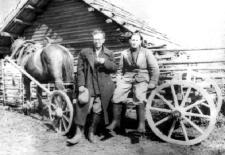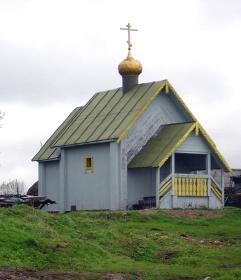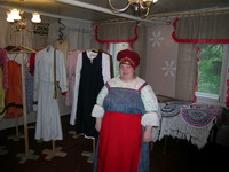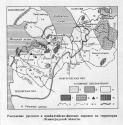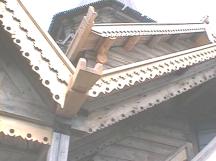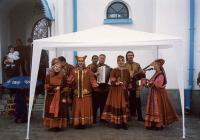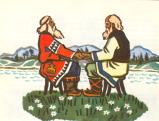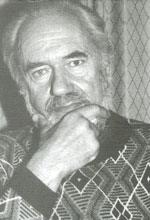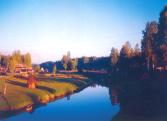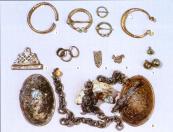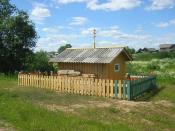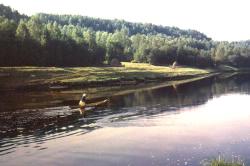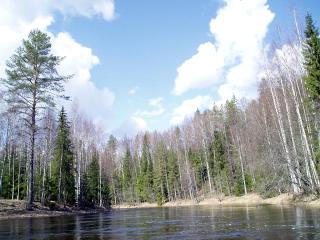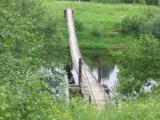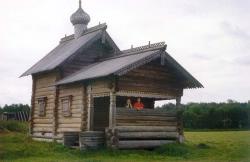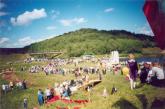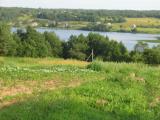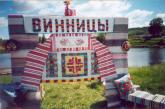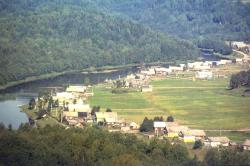Articles
/
Veps
Veps
Subject /
Ethnic culture/Ethnic communities
Subject /
Ethnic culture/Ethnic communities/
Subject /
Ethnic culture//
Veps (IN FORMER TIMES - Chud (Chudes), Chukhars, Kaivans; Veps' native names in the Leningrad Oblast are Vepsya/Bepsya/Veps, Vepslyayzhet/Vepslaazhed/Bepslaazhed, Lyudinikad, Chukharid) are an ethnic community. The Veps language is related to the Baltic-Finnic subgroup of the Finno-Ugric branch of the Uralic language family. Veps were formed on the area between Ladoga, Onega and Beloye (White) Lakes (in Mezhozerye) as the result of the interaction of newly come Baltic-Finnish groups and local people related to ancestors of the contemporary Sami. Since the end of the 1000s AD the ethnocultural interaction of Veps' ancestors with the Slavs (annalistic nation Ves) has been beginning. The ethnic territory of Veps has been decreasing steadily since c. 2000 AD because of assimilation. These days Veps live on the adjoining areas of the Leningrad Oblast, the Vologda Oblast and Karelian Republic. They are divided into north, middle and south ethnographic groups. In the Leningrad Oblast Veps inhabit the northern and northeastern part of Boksitogorsk District (the south group), the northeastern part of Tikhvin District, the southeastern part of Lodeynoye Pole District and the southern part of Podporozhye District (the middle group). The total number of Veps in Russia is 8240 people including those who live in the Leningrad Oblast - 2019 people (according to the data of population census in 2002). Farming and cattle-raising were the main occupations of Veps in the 20th century. Hunting, fishing, gathering, furriery, shoe-making, cooperage were the secondary occupations. Veps' settlements had free layout, small sizes and they were situated near the reservoirs. The type of their homes is similar the North Central Russian one. Village community was the foundation of their social organization. Kinship ties were very important. Their main food was flour products. Their rich folklore has been preserved. Veps have their own written language based on the Roman alphabet. The Veps language is taught at schools as an optional subject and some literary works and the newspaper "Kodima" ("Rodnaya zemlya" ("Native Land") are published in the Veps language. Veps' folk art is presented with wood carving, plaiting things from birchbark, small clay sculptures (the area near the Oyat river), embroidery, weaving. Veps' traditional world outlook has kept some heathen elements such as worshipping trees and animals, belief in spiripts-masters. Religious Veps are members of the orthodox church. At present some missionary work is being carried out among Veps by representatives of Protestant confessions.
Authors
Yegorov, Sergey Borisovich
Geography
Topographical landmarks/Beloye Lake (White Lake). (Mezhozerye)
Leningrad Oblast, the/Boksitogorsk District
Neighbouring Territories/Karelian Republic
Topographical landmarks/Ladoga Lake
Leningrad Oblast, the/Lodeynoye Pole District
Topographical landmarks/Mezhozerye
Topographical landmarks/Onega Lake
Topographical landmarks/Oyat River, the
Leningrad Oblast, the/Podporozhye District
Leningrad Oblast, the/Tikhvin District
Neighbouring Territories/Vologda Oblast, the
Bibliography
Проблемы истории и культуры вепсской народности. Петрозаводск, 1989, С.4-26
Винокурова И.Ю. Календарные обычаи, обряды и праздники вепсов (конец XIX начало ХХ в.). СПб., 1994., С.4-26
Пименов В. В. Вепсы : очерк этн. истории и генезиса культуры / В.В. Пименов.– М.; Л., 1965.– 264 с., С.4-26
Косменко А.П. Народное изобразительное искусство вепсов. Л., 1984., С.4-26
Прибалтийско-финские народы России. М., 2003., 324-467
Современная наука о вепсах: достижения и перспективы (памяти Н.И.Богданова). Петрозаводск, 2006, 324-467
Subject Index
"Kodima" ("Rodnata Zemlya" ("Native Land")), a newspaper
Mentioned in articles:
|
hidden
|
Bogdanov, Nikolay Ivanovich (1904-1959), a scholar
Nikolay Ivanovich Bogdanov (1904-1959) was a linguist, one of the makers of the Veps(ian) language and written language. He graduated from the philological faculty of the Leningrad University (1938), he was a student of professor D.V.Bubrich. In... more
|
|
|
|
hidden
|
Boksitogorsk District
BOKSITOGORSK DISTRICT, a part of Leningrad Oblast. Population: 34,800. Area: 7163 sq. km. Adm. center: Boksitogorsk Town. The district comprises Yefimovsky urban settlement and 275 inhabited localities. It borders Tikhvin District of Leningrad... more
|
|
|
|
hidden
|
Centre of the Veps folklore, the
The Centre of the Veps folklore (Vinnitsi Village, Podporozhsky District) was made in the local culture house. It is situated in the two-storeyed wooden building. The tasks of the Centre of the Veps folklore are keeping the Veps language and... more
|
|
|
|
hidden
|
Ethnic groups if the Leningrad Oblast
Ethnic communities of the Leningrad Oblast. The settled communities of people historically formed on the certain territory, having the common features of culture and self-consciousness expressed in the native name are called an ethnic community (or... more
|
|
|
|
hidden
|
Façade carving
FAÇADE CARVING. With the development of peasant woden architecture, woodcarving also developed. Carving was used for decoration of spouts under the roof. Carving (at first blind carving, in the end of the XIX c. – carving with holes) was also used... more
|
|
|
|
hidden
|
Finno-Ugric nations
Finno-Ugric nations are ethnic communities speaking the languages of the Finno-Ugric group which is a part (together with the Samoyedic and Yukaghir groups) of the Ural (Uralic-Yukaghir) language family. Finno-Ugric nations have lived historically... more
|
|
|
hidden
|
Flklore centres
FOLKLORE CENTRES. The program of culture development in the Leningrad Oblast is worked out taking into account multiethnic population and it stimulates creation of conditions for revival, preservation and development of native population’s national... more
|
|
|
|
hidden
|
Folklore
FOLKLORE of folks living in the Leningrad Oblast (ref. Ethnic communities in Leningrad Oblast) is multilayer polyethnic heritage which appeared as a result of rich history of the region. One of the first people to study the Veps in the period of... more
|
|
|
|
hidden
|
Goryshin, Gleb Aleksandrovich (1931-1998), a literary man
Gleb Aleksandrovich Goryshin (1931-1998), a literary man. He was born in Leningrad city and spent his childhood in the urban settlement of Vyritsa. In 1954 Goryshin graduated from the Journalism Faculty of the Leningrad State University. Till 1957... more
|
|
|
|
hidden
|
Kolmogorov, Aleksandr Ivanovich (1870-1822), a scientist
Kolmogorov, Aleksandr Ivanovich (1870-1822), an archaeologist, ethnographer, anthropologist, full member of the Society of Natural History, Archaeology and Ethnography Lovers (1906), Master of Geography and Ethnography (1908), professor (1918). ... more
|
|
|
hidden
|
Kurba, settlement
KURBA, a settlement in Podporozhye District. Population: 368. Located in the upper reaches of the Oyat River. The name originates from the Kurba River, a left-hand tributary of the Oyat. It was founded in 1959 as a settlement for timber harvesters.... more
|
|
|
|
hidden
|
Kurgans (barrows) of the southern Ladoga Lake region.
Kurgans (barrows, burial mounds) of the southern Ladoga Lake region (the late 9th - early 13th centuries) pertain to so-called the Lake Ladoga region Chuds whose descendants took part in forming Vepses and Karels. They were likely to be "kolbyagi",... more
|
|
|
|
hidden
|
Ladva, group of villages
LADVA, a group of Veps villages in the south-eastern part of Podporozhye District. Located on the banks of the Oyat River and Lake Ladvinskoye. It consists of the villages of Vasilievskaya, Kazychenskaya, Makarievskaya, Minitskaya, Fyodorovskaya,... more
|
|
|
|
hidden
|
Lodeynoye Pole District
LODEYNOYE POLE DISTRICT, a part of Leningrad Oblast located east of Lake Ladoga in the Svir River basin. In the north-west and north, it borders Olonets District of the Republic of Karelia; in the north-east and east, Podporozhye District; in the... more
|
|
|
|
hidden
|
Mordvinov, Isaaky Petrovich (1871-1925), a literary man, scientist
Mordvinov, Isaaky Petrovich (1871, Tikhvin Town -1925, Tikhvin Town), a local historian, literary man, enlightener. From 1885 Mordvinov worked as a volost clerk in the Bolshegorsky volost of the Tikhvin uyezd. V.D. Krenke has the great ... more
|
|
|
|
hidden
|
Obonezhye
OBONEZHYE, historic and cultural region in the north-west of the European Russia. It included lands around Lake Onega. A part of the state of Novgorod: written sources from the 12th century mention the Obonezhskaya Hundred as an adm. and territorial... more
|
|
|
|
hidden
|
Oyat River, the
OYAT, river, left-hand tributary of the Svir River. Length: 266 km. The average flow rate in the mouth is 54.8 cu. m/s, catchment area: 5220 sq. km. Its source is Lake Chaimozero on the Veps Hills (in Vologda Oblast, 7 km away from the Leningrad... more
|
|
|
|
hidden
|
Oyatskaya ceramics
OYAT POTTERY. Pottery existed in Russian and Veps villages on the Oyat River (modern Lodeynoye Pole District) from time immemorial. It was due to deposits of high quality red clay. Pottery was especially developed in the XVIII c. Oyat potters... more
|
|
|
|
hidden
|
Pasha River, the
PASHA, river, left-hand tributary of the Svir River. Length: 242 km. The average flow rate in the mouth is 69.2 cu. m/s, catchment area: 6650 sq. km. It flows out of Lake Pashozero in the east of Leningrad Oblast, and crosses Tikhvin and Volkhov... more
|
|
|
|
hidden
|
Podporozhye Central Library, the
THE PODPOROZHYE CENTRAL LIBRARY (9 Lenin Prospekt, Podporozhye Town). The library was founded in 1944. In 1977 in the process of integration of the district libraries into a centralized library network it was given the status of central district... more
|
|
|
|
hidden
|
Podporozhye District
PODPOROZHYE DISTRICT, municipal entity. Population: 35,200. Area: 7705.5 sq. km. Located in the north-east of Leningrad Oblast. In the north-west and north, it borders Olonets, Pryazha, and Prionezhsky Districts of the Republic of Karelia; in the... more
|
|
|
|
hidden
|
Population
Population. According to the census of 2002 in the Leningrad Oblast there were 1669,205 thousand people; according to the estimate made on 1 July 2005 there were 1647,6 thousand people including the town dwellers numbering 1093,9 thousand people... more
|
|
|
hidden
|
Pulkin, Vasily Andreyevich (1923-1985), a literary man
Pulkin, Vasily Andreyevich (1923, Nyurgovichi village of the Lukinskaya volost, the Tikhvin uyezd, the Cherepovetsk gubernia (now it is the Tikhvin district of the Leningrad oblast) - 1985), a writer, teacher. V.A. Pulkin graduated from the factory... more
|
|
|
hidden
|
Russians
Russians are an ethnic community, the main population of the Russian Federation. Among Russians there are some ethnic groups and ethnographic groups can be marked (e.g. Cossacks and Pomors (coast-dwellers (inhabitants of White Sea and Barents Sea... more
|
|
|
hidden
|
Singers of runes
Singers of runes (in Finnish - runonlaulajat) are performers of folk poetic works at the Baltic-Finnic nations (Karelians, Izhora, Votes, Veps), narrators of folk tales (in Finnish runo is a poem, rune). The repertoire of the singers of runes... more
|
|
|
hidden
|
"The Tree of Life", a vepses festival
“DEREVO ZHIZNY” (“TREE OF LIFE”), Veps festival – a holiday of Veps culture. Veps name is “Elon Pu”. The festival was organized in 1987 in Vinnitsy Village, Podporozhye District, one of the centres of Veps culture, on the initiative of the... more
|
|
|
|
hidden
|
Tikhvin District
TIKHVIN DISTRICT, municipal entity. Population: 14,600. Area: 6997.5 sq. km. Adm. center: Tikhvin Town. The district comprises 198 rural localities united into 8 rural settlements. It is located in the east and south-east of Leningrad Oblast. It... more
|
|
|
|
hidden
|
Traditional business and handicraft
TRADITIONAL TRADES AND HANDICRAFTS originated from household occupations and crafts which were aimed at production of household objects for the peasants' own needs. Originality of traditional trades in Leningrad Oblast is connected... more
|
|
|
|
hidden
|
"Veshchy Gamayun" ("Prophetic Gamayun"), a magazine
"Veshchy Gamayun" ("Prophetic Gamayun")(Tikhvin Town), a social,political, literary,artistic,historic and regional oblast magazine. Constitutor is «Editorial Staff-Publishing House of Enterprise “Gamayun”» Ltd. From 1999 to 2002 five issues... more
|
|
|
|
hidden
|
Vinnitsi Rural Library, the
VINNITSI VILLAGE LIBRARY (Vinnitsi Village, 64 Sovetskaya Street). The library was opened in the village before 1917 (the precise date of the foundation is unknown). Fom 1977 to 2005 the library was integrated into centralized library network as its... more
|
|
|
|
hidden
|
Volkov, Nikolay Nikolayevich (1904-1953), a scholar
Nikolay Nikolayevich Volkov (1904-1953) was a scientist-ethnographer. He graduated from the ethnography department of the geography faculty of the Leningrad State University (1930). In the period from 1931 to 1935 he was mobilized to work in the... more
|
|
|
hidden
|
Vyaysyanen, Armas Otto (1890-1969), an ethnographer
Armas Otto Vaisanen (1890-1969) was a folklorist, ethnographer. He studied at the University of Helsinki. In 1919 he became a Master, then in 1939 he became a Doctor of Science. Since 1919 he was a member of the Kalevala Society, in 1930-42 he was... more
|
|
|
hidden
|
Yaroslavichi, village
YAROSLAVICHI, a village in Podporozhye District. Population: 216. Located on the right bank of the Oyat River. The motor road connecting the village to Vinnitsi and Alyokhovschina extends cross Y. The Russian name is related to the ancient Slav name... more
|
|
|
|
hidden
|
|
hidden
|
|
hidden
|
|
hidden
|
|





